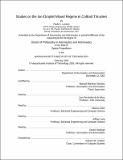Studies on the ion-droplet mixed regime in colloid thrusters
Author(s)
Lozano-Tovar, Paulo César, 1970-
DownloadFull printable version (2.513Mb)
Other Contributors
Massachusetts Institute of Technology. Dept. of Aeronautics and Astronautics.
Advisor
Manuel Martínez-Sánchez.
Terms of use
Metadata
Show full item recordAbstract
Colloid thrusters working with mixtures of ions and droplets are gradually becoming an alternative technology for space micro-propulsion needs in missions requiring high position controllability, compactness and low power consumption. The mechanics of the colloid thruster emission process are discussed through a theoretical review of its general properties and by means of experimental characterization. Droplets are the most energetic particles in the beam, while ions are emitted with energies that overlap those of the droplets but extend down a few hundreds of volts in comparison. A small fraction of the ion current is emitted from the jet breakup region with considerably lower energies. This energy variety transforms the optical hardware elements into energy filters by taking advantage of the chromatic aberration property of electrostatic lenses. The relatively wide ion energy distribution is conceptually explained as a result of emission from different locations in the cone-jet structure where the normal electric field is most intense and where the convective current produces drastic changes in the local potential. The energy spread of purely ionic emission from EMI-BF4 is measured and is found to be of the order of a few tens of volts. A high-speed electron multiplier detector is used for the first time to analyze the ion component emitted directly from electrospray sources. Ion identification is performed and is found that the most probable degree of solvation is n = 5.1 for (CH3NO)nNa+ ions in formamide doped with NaI for a conductivity of 2.15 siemens per meter. (cont.) Two ions are observed for the ionic liquid EMI-BF4: EMI+ and (EMI-BF4)EMI+. It is found that these ions are emitted with a small energy differential. The use of 5 micron ID capillary emitters, working with flow rates close to 20 pico-liters per second, is successfully achieved. Under such conditions, highly charged droplets with specific charges in excess of 10 coulombs per gram are obtained, representing the highest charge state obtained so far in experiments of this kind. The applicability of colloid thrusters for space propulsion is discussed in terms of performance parameters in the ion-droplet mixed regime, along with other practical considerations, such as the problem of beam neutralization.
Description
Thesis (Ph. D.)--Massachusetts Institute of Technology, Dept. of Aeronautics and Astronautics, 2003. Page 222 blank. Includes bibliographical references (p. 217-221). This electronic version was submitted by the student author. The certified thesis is available in the Institute Archives and Special Collections.
Date issued
2003Department
Massachusetts Institute of Technology. Department of Aeronautics and AstronauticsPublisher
Massachusetts Institute of Technology
Keywords
Aeronautics and Astronautics.